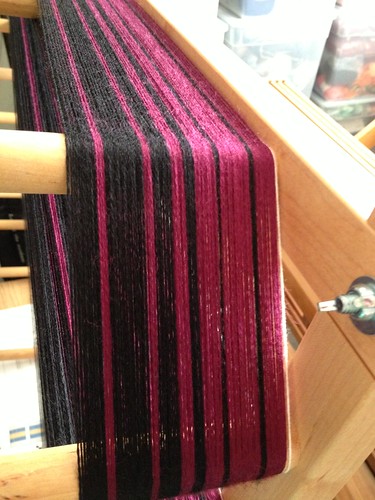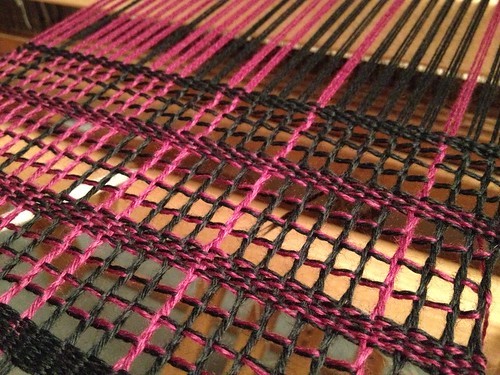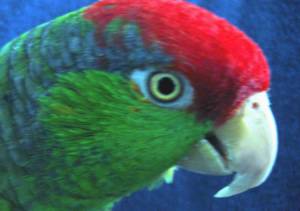Why didn't anyone tell me??
I read the discussion boards on Ravelry regularly and there are so many times when I think that the person's question could be answered if they just created a swatch and washed it. "Just do it," says my inner voice, "because how can I know how the fabric you create will or won't change with blocking? Make a swatch and wash it."
Yes, swatching & washing in knitting can answer a lot of questions before umpteen hours are invested in the real project.
But this post isn't about knitting, it's about weaving. Have I mentioned that I've never "sampled" in weaving? Sampling is the weaver's equivalent to swatching. Oh no, I've just warped and wove. But if I sampled, maybe that chenille "scarf" wouldn't have ended up as dense and as stiff as new denim. It could have been upholstery fabric if it was wider. Instead, I made it into a yoga mat bag.
I found a bead leno scarf project in a Handwoven ebook that looked interesting. Bead leno doesn't refer to beads that are woven into the fabric, rather the beads are used to redirect warp threads when certain treadles are pressed. The warp threads twist, the weft is passed through the warp, and the twist becomes part of the fabric. It sounded intriguing and not completely out of my league, so I dove in the stash and found yarn for it.
The yarn used in the ebook project was a sport weight yarn, but I wanted to use Colrain Lace, a 50-50 Merino Tencel yarn that I bought at Stitches West 2012. I asked for guidance from the 4-shaft weaving group on Facebook for a sett to start with. They suggested trying 12 epi, but to be prepared to re-sley if I didn't like the fabric. That's what I planned for, 12 epi. The warp length in the project allowed for sampling. I thought I'd throw a few picks, get a feel for the project, then start weaving. Certainly I wouldn't have to cut the sample off and wash it because really, how much would it change?
Happily, I prepared a 5 yard warp of 120 ends. Everything went relatively quickly compared to my last projects that had 500+ ends.

Striped warp
The beads were put in place and I was ready to start. But once I started weaving my sample, I was shocked. This didn't look like lace, it looked like a fish net! Ugh, this was not the look I expected. Maybe I needed to re-sley at 16 epi? Maybe I needed change my approach completely, take the beads out and go with a 4-3-2-1 twill?

Bead Leno sample
Maybe it was me. Maybe I wasn't open to change. I knew twill, but I didn't know lace. Maybe this would be okay as-is. It didn't have to look like every other thing I made. To get some reassurance, I posted the photo in the weaving group to get feedback.
The comments I received were positive, but there were 2 comments that made me think that there was more to this than met the eye--
Margaret said, "It looks like Leno to me."
I thought, "Really? So this is what leno looks like on the loom? But it doesn't look like the project in the ebook."
Su said, "I like the look of the leno and will be anxious to see what happens off the loom and after wet finishing. I think it will be beautiful!"
Wait a second. Something happens in the wet finishing process. This wasn't the end product! I needed to take the fabric through the final process so it could become what it's suppose to be.
Gee, does that sound familiar? MAKE A SWATCH AND WASH IT. Well that's exactly what I did last night. I finished the sample and gave it a bath in Eucalan.
Why didn't anyone tell me??

Bead Leno sample after wet finishing
Project details on Ravelry
Yes, swatching & washing in knitting can answer a lot of questions before umpteen hours are invested in the real project.
But this post isn't about knitting, it's about weaving. Have I mentioned that I've never "sampled" in weaving? Sampling is the weaver's equivalent to swatching. Oh no, I've just warped and wove. But if I sampled, maybe that chenille "scarf" wouldn't have ended up as dense and as stiff as new denim. It could have been upholstery fabric if it was wider. Instead, I made it into a yoga mat bag.
I found a bead leno scarf project in a Handwoven ebook that looked interesting. Bead leno doesn't refer to beads that are woven into the fabric, rather the beads are used to redirect warp threads when certain treadles are pressed. The warp threads twist, the weft is passed through the warp, and the twist becomes part of the fabric. It sounded intriguing and not completely out of my league, so I dove in the stash and found yarn for it.
The yarn used in the ebook project was a sport weight yarn, but I wanted to use Colrain Lace, a 50-50 Merino Tencel yarn that I bought at Stitches West 2012. I asked for guidance from the 4-shaft weaving group on Facebook for a sett to start with. They suggested trying 12 epi, but to be prepared to re-sley if I didn't like the fabric. That's what I planned for, 12 epi. The warp length in the project allowed for sampling. I thought I'd throw a few picks, get a feel for the project, then start weaving. Certainly I wouldn't have to cut the sample off and wash it because really, how much would it change?
Happily, I prepared a 5 yard warp of 120 ends. Everything went relatively quickly compared to my last projects that had 500+ ends.

Striped warp
The beads were put in place and I was ready to start. But once I started weaving my sample, I was shocked. This didn't look like lace, it looked like a fish net! Ugh, this was not the look I expected. Maybe I needed to re-sley at 16 epi? Maybe I needed change my approach completely, take the beads out and go with a 4-3-2-1 twill?

Bead Leno sample
Maybe it was me. Maybe I wasn't open to change. I knew twill, but I didn't know lace. Maybe this would be okay as-is. It didn't have to look like every other thing I made. To get some reassurance, I posted the photo in the weaving group to get feedback.
The comments I received were positive, but there were 2 comments that made me think that there was more to this than met the eye--
Margaret said, "It looks like Leno to me."
I thought, "Really? So this is what leno looks like on the loom? But it doesn't look like the project in the ebook."
Su said, "I like the look of the leno and will be anxious to see what happens off the loom and after wet finishing. I think it will be beautiful!"
Wait a second. Something happens in the wet finishing process. This wasn't the end product! I needed to take the fabric through the final process so it could become what it's suppose to be.
Gee, does that sound familiar? MAKE A SWATCH AND WASH IT. Well that's exactly what I did last night. I finished the sample and gave it a bath in Eucalan.
Why didn't anyone tell me??

Bead Leno sample after wet finishing
Project details on Ravelry
Labels: beads, Gilmore, lace, leno, Merino, Tencel, weaving, wool

3 Comments:
Nice! I personally get a little squeamish thinking about 'swatching' a weaving project -- it seems like I will waste a lot of yarn that way. At least with knitting I can undo and reuse if I don't block....
By Mo, at 5/15/2013 5:17 PM
Mo, at 5/15/2013 5:17 PM
Wow - big difference! It's still quite open - do you like this fabric, or will you adjust anything before you weave?
By spinnity, at 5/15/2013 5:48 PM
spinnity, at 5/15/2013 5:48 PM
Mo: I know what you mean. That's probably why I haven't sampled until now.
Spinnity: I like this fabric, so I'll weave it as-is.
By Bogie, at 5/15/2013 7:27 PM
Bogie, at 5/15/2013 7:27 PM
Post a Comment
<< Home